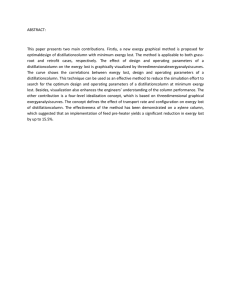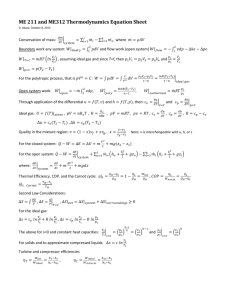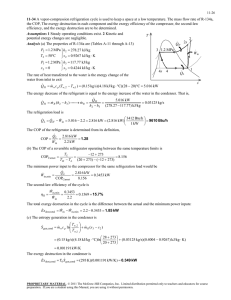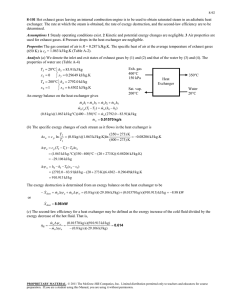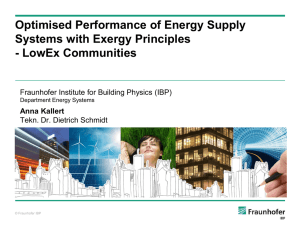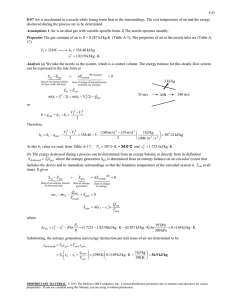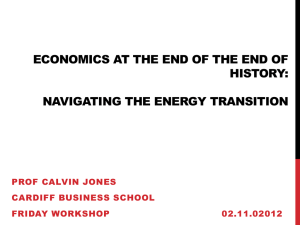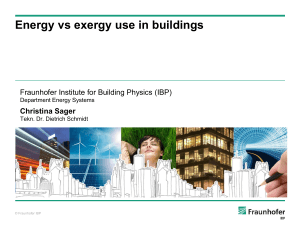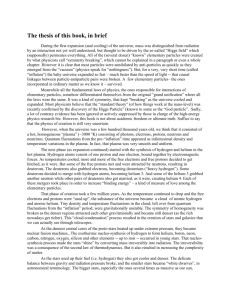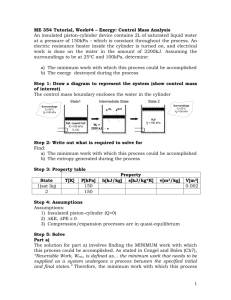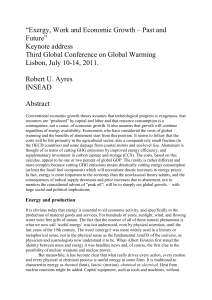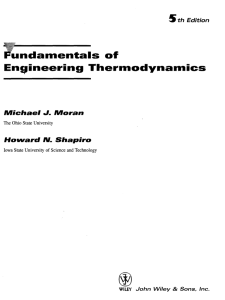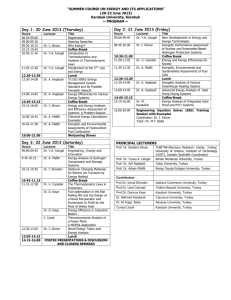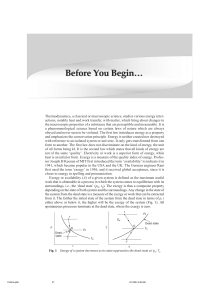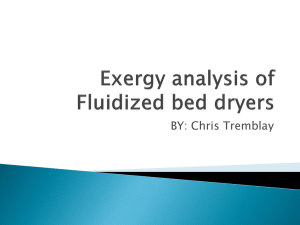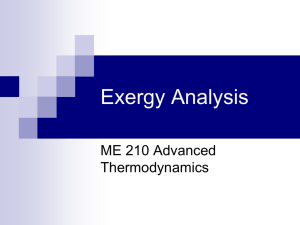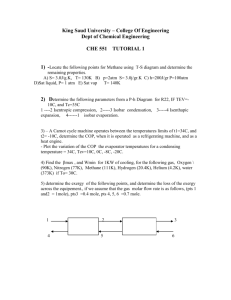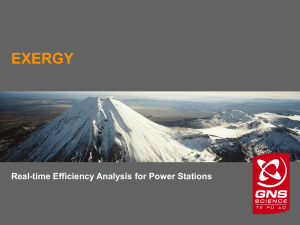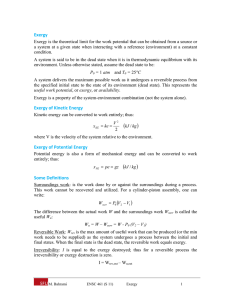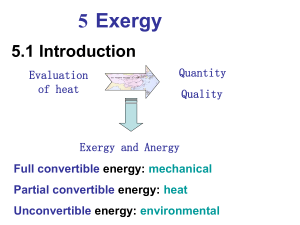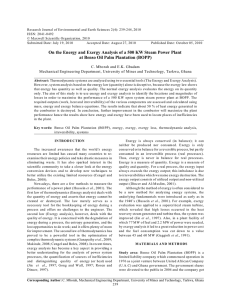Parametric analysis
advertisement
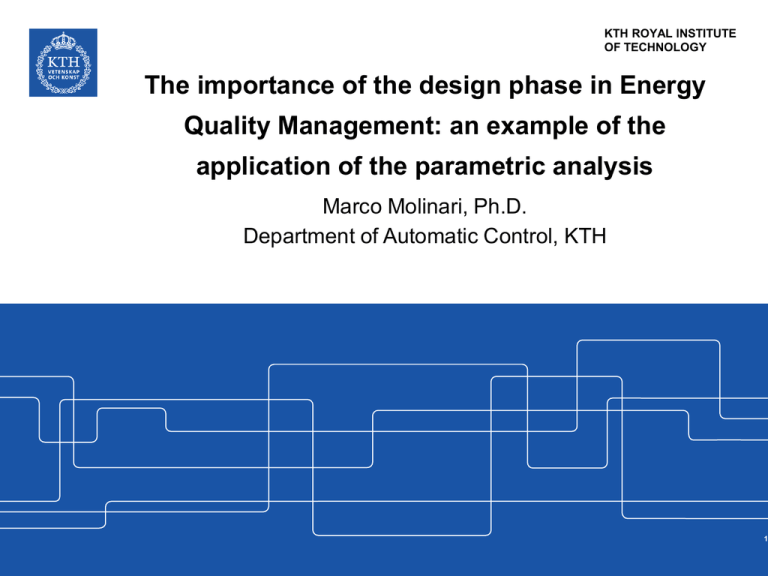
KTH ROYAL INSTITUTE OF TECHNOLOGY The importance of the design phase in Energy Quality Management: an example of the application of the parametric analysis Marco Molinari, Ph.D. Department of Automatic Control, KTH 1 Outline • Background • Energy efficiency targets in the built environment • Tools for analysis: S.E.P.E. • S.E.P.E.in practice: performance improvement with exergy analysis • GSHP improvement through integrated design • Current research • Conclusions 2 Energy use in the world: the need for reduced and more sustainable energy use World total primary energy supply World End-Use Energy, 2009 14000 Other 12000 10000 Combustible renewables and waste 87% Commerce and public services 8% Agriculture forestry 2% Non specified 2% Hydro Industry 36% Mtoe 8000 32% Nuclear 6000 Gas 4000 Coal/peat 2000 Oil 0 1973 Residential 24% Transport 28% 2008 year Source: IEA 2010 Total: 8353 MTOE Source: IEA 2011 3 Energy and exergy efficiency Energy supply type in buildings Source: Fraunhofer IBP Source: Mure Odyssey database 4 Can we improve our energy management by means of exergy concepts? • Energy quality (exergy) mismatch between supply and demand indicates potential for energy management improvements • Main hindrances: • Lack of a shared understanding of the advantages of the exergy approach • No standardized exergy analysis calculation tools available • Need for demonstration projects 5 Examples of available exergy analysis software programs: IEA ECBCS Annex 49 • Human Body Exergy Calculation • Cascadia – An Exergetic Approach to Neighbourhood Design • Pre-Design Tool for buildings exergy analysis • DPV Tool • S.E.P.E. – Software for Exergy Performance Assessment 6 S.E.P.E. HVAC components • • Generators – HPs, – chillers – boilers – solar collectors – DH Heat exchangers • • • Distribution components – Ducts/pipes – Fans and pumps Emission systems – radiators – FH – air units – controllers Simplified building envelope 7 Component example: boiler 8 Example of S.E.P.E. HVAC system assembly 9 Improvement of heat pumps COP performance with S.E.P.E. T10 T11= 55° DHW T9 T12= 10°C Heat Exchanger 2 T8 Tset= 22°C Reservoir Heat Exchanger 1 T2 T4 T5 P2 Heat Pump 2 T7 Floor Heating System Reservoir T1 T3 Heat Exchanger 3 P1 Heat Pump 1 T6 Reservoir T0 10 Results COP COP 4.5 4.5 4.3 4.1 3.9 3.7 3.5 3.3 3.1 2.9 4.3 4.1 3.9 3.77 3.7 3.5 3.3 3.12 3.1 3.03 3.03 2.9 0 5 10 Heat exchanger 2 area [m2] 15 4,17 4.05 3.92 3.77 20 40 Reservoir 1 temperature [°C] The same physical system can achieve different performance if the subsystems are not properly matched 11 How to extend these results to other fields: design of ground source heat pumps Building heated area: 8000 m2 Locations: Stockholm and Madrid Parametric study • Building envelope – Walls and roof insulation • Borehole field http://sustainableenergysystemz.com/the-benefits-of-ground-source-heat-pumps/1679/ – Borehole spacing – Number of boreholes 12 Madrid Results: Stockholm 13 Current research at KTH: advanced control strategies in buildings 14 Conclusions • Conceptual and calculation tools for energy quality management already exist and are now mature enough to shift from research to applications • The application of exergy concepts can be highly valuable to the improvement of the design of buildings, especially in connection to parametric analysis • Examples of improved design of buildings and buildings components based on exergy principles are needed to show the potential improvements in energy quality management • Advanced controls schemes and exergy can be an innovative match to further decrease the overall energy used in buildings 15 Thank you for your attention! 16
